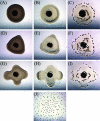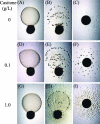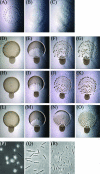Multicellular development in Myxococcus xanthus is stimulated by predator-prey interactions
- PMID: 17513469
- PMCID: PMC1951827
- DOI: 10.1128/JB.00544-07
Multicellular development in Myxococcus xanthus is stimulated by predator-prey interactions
Abstract
Myxococcus xanthus is a predatory bacterium that exhibits complex social behavior. The most pronounced behavior is the aggregation of cells into raised fruiting body structures in which cells differentiate into stress-resistant spores. In the laboratory, monocultures of M. xanthus at a very high density will reproducibly induce hundreds of randomly localized fruiting bodies when exposed to low nutrient availability and a solid surface. In this report, we analyze how M. xanthus fruiting body development proceeds in a coculture with suitable prey. Our analysis indicates that when prey bacteria are provided as a nutrient source, fruiting body aggregation is more organized, such that fruiting bodies form specifically after a step-down or loss of prey availability, whereas a step-up in prey availability inhibits fruiting body formation. This localization of aggregates occurs independently of the basal nutrient levels tested, indicating that starvation is not required for this process. Analysis of early developmental signaling relA and asgD mutants indicates that they are capable of forming fruiting body aggregates in the presence of prey, demonstrating that the stringent response and A-signal production are surprisingly not required for the initiation of fruiting behavior. However, these strains are still defective in differentiating to spores. We conclude that fruiting body formation does not occur exclusively in response to starvation and propose an alternative model in which multicellular development is driven by the interactions between M. xanthus cells and their cognate prey.
Figures






Similar articles
-
Predataxis behavior in Myxococcus xanthus.Proc Natl Acad Sci U S A. 2008 Nov 4;105(44):17127-32. doi: 10.1073/pnas.0804387105. Epub 2008 Oct 24. Proc Natl Acad Sci U S A. 2008. PMID: 18952843 Free PMC article.
-
AsgD, a new two-component regulator required for A-signalling and nutrient sensing during early development of Myxococcus xanthus.Mol Microbiol. 1999 Oct;34(2):268-81. doi: 10.1046/j.1365-2958.1999.01594.x. Mol Microbiol. 1999. PMID: 10564471
-
Short-range C-signaling restricts cheating behavior during Myxococcus xanthus development.mBio. 2024 Nov 13;15(11):e0244024. doi: 10.1128/mbio.02440-24. Epub 2024 Oct 18. mBio. 2024. PMID: 39422488 Free PMC article.
-
Molecular Mechanisms of Signaling in Myxococcus xanthus Development.J Mol Biol. 2016 Sep 25;428(19):3805-30. doi: 10.1016/j.jmb.2016.07.008. Epub 2016 Jul 16. J Mol Biol. 2016. PMID: 27430596 Review.
-
Intercellular signaling during fruiting-body development of Myxococcus xanthus.Annu Rev Microbiol. 1999;53:525-49. doi: 10.1146/annurev.micro.53.1.525. Annu Rev Microbiol. 1999. PMID: 10547700 Review.
Cited by
-
The enhancer binding protein Nla6 regulates developmental genes that are important for Myxococcus xanthus sporulation.J Bacteriol. 2015 Apr;197(7):1276-87. doi: 10.1128/JB.02408-14. Epub 2015 Feb 2. J Bacteriol. 2015. PMID: 25645554 Free PMC article.
-
Quantitative Analysis of Lysobacter Predation.Appl Environ Microbiol. 2015 Oct;81(20):7098-105. doi: 10.1128/AEM.01781-15. Epub 2015 Jul 31. Appl Environ Microbiol. 2015. PMID: 26231654 Free PMC article.
-
Identification of Functions Affecting Predator-Prey Interactions between Myxococcus xanthus and Bacillus subtilis.J Bacteriol. 2016 Nov 18;198(24):3335-3344. doi: 10.1128/JB.00575-16. Print 2016 Dec 15. J Bacteriol. 2016. PMID: 27698086 Free PMC article.
-
Myxobacterial Predation: A Standardised Lawn Predation Assay Highlights Strains with Unusually Efficient Predatory Activity.Microorganisms. 2023 Feb 4;11(2):398. doi: 10.3390/microorganisms11020398. Microorganisms. 2023. PMID: 36838363 Free PMC article.
-
Culture-dependent and -independent methods revealed an abundant myxobacterial community shaped by other bacteria and pH in Dinghushan acidic soils.PLoS One. 2020 Sep 14;15(9):e0238769. doi: 10.1371/journal.pone.0238769. eCollection 2020. PLoS One. 2020. PMID: 32925929 Free PMC article.
References
-
- Braeken, K., M. Moris, R. Daniels, J. Vanderleyden, and J. Michiels. 2006. New horizons for (p)ppGpp in bacterial and plant physiology. Trends Microbiol. 14:45-54. - PubMed
-
- Cho, K., and D. R. Zusman. 1999. Sporulation timing in Myxococcus xanthus is controlled by the espAB locus. Mol. Microbiol. 34:714-725. - PubMed
Publication types
MeSH terms
Substances
Grants and funding
LinkOut - more resources
Full Text Sources
Other Literature Sources

